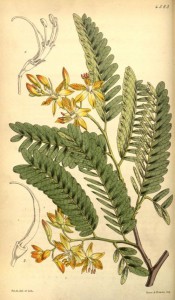Tamarindus indica L.
Frost-tender, long-lived evergreen tree with an open, spreading crown, feathery foliage and fragrant, pale yellow flowers, veined with red or rose, in summer, followed by pod-like fruit containing a dense, chocolate- or rose-coloured flesh. To 25m. [RHSD, Hortus].
Horticultural & Botanical History
An important commercial crop. Tamarind fruit is rich in minerals and vitamins and is used as fresh pods, processed pulp or refined extracts to flavour food. Introduced to Britain in 1633. [JD]. Don.
‘Most authors make two species of Tamarindus, the Indian kind, with long pods, and the West Indian, with short pods: but even those who adopt this view of the subject generally raise a question of their specific identity. India is probably the aboriginal country of both, whence the species was introduced to Western India. Even in the East the Tamarinds of the Archipelago are considered the best of those of India. The Arabs called the tree “Tamr hindee,” or Indian Date, from which has been derived the generic name Tamarindus. Our small Tamarind-tree, in the Royal Gardens, about fourteen feet high, whence our flowering specimens were taken, is probably the West Indian variety, and can give no idea of the general appearance of a full-grown tree, which all travelers agree in saying is one of the noblest objects in nature.’ [BM t.4563/1851].
History at Camden Park
Listed only in the 1857 catalogue [T.971/1857] but first recorded in a handwritten note in an 1850 catalogue held at the Mitchell Library. [MP A2947A].
Notes
Published Dec 26, 2009 - 10:39 AM | Last updated Jul 21, 2010 - 02:33 PM
| Family | Fabaceae |
|---|---|
| Category | |
| Region of origin | Tropics |
| Synonyms |
|
| Common Name | Tamarind |
| Name in the Camden Park Record |
Tamarindus indica |
| Confidence level | high |


